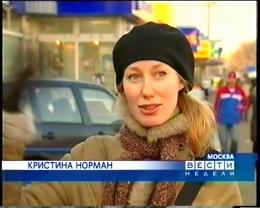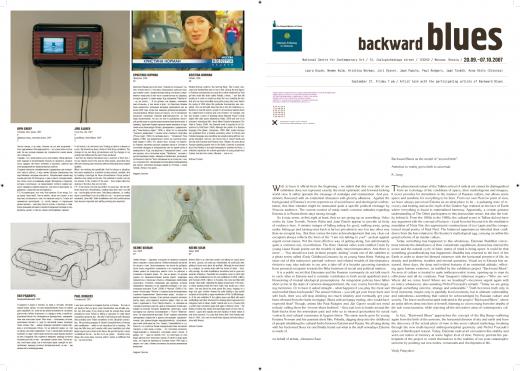TAGURPIDI BLUUS
PRESSITEADE 19.09.2007
Tagurpidi bluus
Moskvas, Venemaa Kaasaegse Kunsti Keskuses avatakse 19. septembril kell 17.00 eesti kunstnike grupinäitus “Tagurpidi-bluus”. Anna Hints, Laura Kuusk, Neeme Külm, Kristina Norman, Jüri Ojaver, Jaan Paavle, Paul Rodgers ja Jaan Toomik pakuvad Moskva kunstipublikule videos, fotos ja installatsioonides järelemõtlemisainet kultuurilise konsensuse loomise mehhanismide üle. Arvestades Eesti ja Vene praegusi suhteid on teema enam kui aktuaalne, ometi ei torka näitus silma konstruktiivse ja elujaatava hoiakuga. Kunstnikud on pigem dokumenteerinud maailmavaateliste ebakõlade ja kultuurilise kolonialismi sünnimomente, eksistentsiaalseid valikuid erinevate kultuuridiskursuste vahel ning silmitsiseismist surmaga. 21. septembril kõnelevad kunstnikud kohtumisel Moskva kunstipublikuga oma loomingust.
Näituse korraldajaks on Kaasaegse Kunsti Eesti Keskus.

Kristina Norman. “Pripaldid”. Video. 2006
Näituse inglisekeelsed saatesõnad Vitali Patsjukovilt ja Johannes Saarelt:
Backward Blues as the model of „second birth”
Attention to reality gives birth to universal.
K. Jung
Phenomenality of Tallinn school of radical art cannot be distinguished from an iconology of conditions of space, their mythologems and imagery. It never gives a way to demolition in the manner of Russian culture but allows some space and sunshine to everything to be born. From our own Moscow point of view, we have always perceived Estonia as an ideal place to be, pulsating zone of recovery and healing and as the myth of Golden Age realised on the face of Earth where everything is found in materialised harmony. Apparently, certain genuine understanding of Other participates at this immaculate sense, but also the reality standing behind of it. From sixties up to eighties of last century the cultural scene of Tallinn did not have an argument with the concept of horizon – it was just hovering beyond it in the meditative mandalas of Tõnis Vint, in suprematist constructs of Leo Lapin and in computerized visual poetry of Raul Meel. Its balanced appearances inherited their confidence from the heir-relation to Ülo Sooster’s mythological egg, carrying on within the grand planetary of insulated culture.
Today something has happened to this wholeness, Estonian Buddhist convictions tolerate their considerate equilibrum to be disturbed, drama has entered the scene and natural cycle of basic states of mind is being upset. It could be something ground-breaking happened – Buddha returned on the face of Earth in order to share his blessed existence with horisontal presence of life, its density and problems, troubles and eternal questions. Visual art of Estonia has assumed these days a deep and evident features of existential attitude, reflecting upon human being, as testifyed by the exhibition project Backward Blues. An area of culture is treated in this thinking quite in antropocentrist terms, opening up to man, its reflections and all its creations. Infamous inquiery of Paul Gauguin – „Who are we? Where are we coming from? Where are we heading?” - becomes urgent again with no notice whatsoever, assisting also to Michel Foucault’s remark on nowadays: „Today we are going through something extreem, strange and unbearable.” Truth becomes truth only in lived moments, maybe only in painfully lived moments, but – what cannot be acknowledged by Russian culture and society – in ultimate vulnerability and nakedness. Brave and honest spirit indicated in the project „Backward Blues”, where an artist delves deep into him or herself, listening to voices rising from depths of subconciousness, while rejecting all the decorative aims of contemporary culture.
In fact, Backward Blues is approaching the concept of Big Bang, suffering again from the birth of universe, horisontal division of skies and earth and from discovery of actual place of man in this sociocultural mythology, breaking through the multilayerness of new antropomorphist geometry, space of flamboyant reason of Michel Foucault. Today Estonian radical art encounters in upper layers of time this shabby and worn-out notion of memory. Memory permits participants of the project to orient themselves in the realities of our post-catastrophical universe by pointing out new nodes, cross-roads and check-points of life.
Vitaly Patsukov
Backward Blues
Well, to have it official from the beginning – we admit that this very title of our exhibition does not represent exactly the most optimistic and forward-looking world view. It rather spreads the message of nostalgia and restauration. And pessimism, flavoured with an existential obsession with gloomy allusions. Against the background of Estonia’s recent experiences of social havoc and ideological confrontation, this blue mindset might be insinuated quite a specific political message by Moscow audience. The current context of ready-made common attitudes regarding Estonia is in Russia these days strong enough.
So it may seem, at first sight at least, that we are giving up on something. Video works by Jaan Toomik, Neeme Külm and Jaan Paavle appear to provide us body of evidence here. A sinister images of falling asleep for good, walking away, going under, letting go and turning ones back is far too prevalent to see it in any other way than an escapist key. But then comes the later acknowledgement that any clear-cut escapism always reflects the form of the “I am not talking to you!”- protest against urgent social issues. Not the most effective way of getting along, but unfortunately quite a common one, nevertheless. The three channel video work entitled Credo by young Laura Kuusk points out the models of daily miscommunication. And there is more … “You should not look at these people, darling” reads one of the subtitles in a photo series called "Early Childhood Lessons" by as young Anna Hints. Making an issue out of this instructive parental violence and related models of discriminatory rhetorics may also indicate in our arts a take-off of a broader upcoming transition from personal escapism towards the filthy business of social and political matters.
It is a public secret that Estonians and the Russian community do not talk much to each other in Estonia and it certainly contributes to both social apartheid and a blossoming of mutual ideological presumptions. An integration policies have fallen short so far. In the state of common disappointment, the cure comes from the lingering memories. Or to have it asked straight – what happens if you play the most sad and morbid blues backwards? The answer follows – you will get your horse back and wife back, then you will stop drinking too much whiskey and eventually get your farm released from the bank mortgage. Blues with an happy ending, who would have expected that? Though, artists like Paul Rodgers and Jüri Ojaver would not mind nobody calling them the ‘reverse blues brothers’ – they just love to hustle around the flash-backs from the immediate past and refer us to missed oportunities for social contracts and cultural consensus at bygone times. The same surely goes for young Kristina Norman and her passeist short film, Pribalts, digging deep into the childhood of people inhabiting the cultural limbo between Estonia and Russia. We all sang along with her backward blues too and finally found out what is the stuff nowadays Estonia is made of.
on behalf of artists,
Johannes Saar

Väljapanekuga kaasneb paralleelselt inglise- ja venekeelne ajaleheformaadis trükis “Backward Blues/Блюз наоборот”, mille veergudel lahatakse eksponeeritavaid teoseid lähemalt.